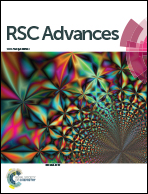Theoretical design and characterization of pyridalthiadiazole-based chromophores with fast charge transfer at donor/acceptor interface toward small molecule organic photovoltaics†
Abstract
A class of D1–A–D2–A–D1-type small molecule (SM) donors (2–5) was engineered via modifying or replacing the core donor moiety in three building blocks based on the reported DTS(PTTh2)2 (1) to screen suitable donor materials for organic photovoltaics (OPV). Density functional theory calculation was performed to investigate the electronic structures, open circuit voltage (Voc) and key parameters closely relevant to the short-circuit current density (Jsc), including (i) absorption spectrum, (ii) electron–hole coherence, (iii) energy driving force, (iv) charge transfer dynamics, and (v) carrier transport efficiency. The results manifest that the designed 2–5 show good performance with large Voc, stable charge transfer and effective charge transport. Surprisingly, the ratios kinter-CT/kinter-CR of 2/PCBM, 3/PCBM, and 5/PCBM heterojunctions present over 104 times higher than that of 1/PCBM. Our conclusions indicate that designed PT-based SMs can better the performance of OPVs, which will provide theoretical guideline for the design and synthesis of new organic SM donors.


 Please wait while we load your content...
Please wait while we load your content...